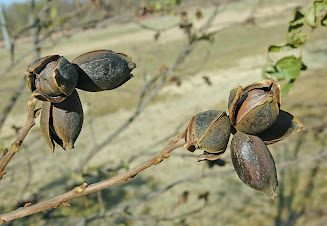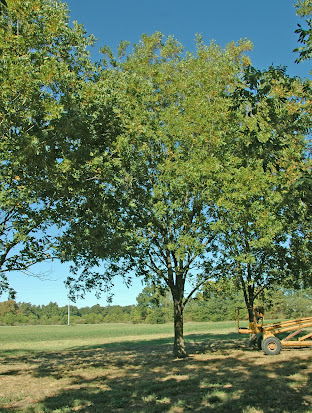Following an extended summer drought and an early Fall freeze, the outlook for my 2022 pecan harvest season looked bleak. Staring up into the canopies of my trees all I could see were small black stick-tights. Should I just walk away from the whole mess or should I attempt to salvage what I could of the 2022 crop? I decided to shake the trees and see if I could recover at least a few edible nuts.
The photo above shows the nuts I collected from a row of Gardner trees using my pecan harvest equipment. Most were sticktights and would have no commercial value. Surprisingly, I discovered a sprinkling of good pecans among those collected. Once I ran the harvested nuts through my pecan cleaner, I ended up with about 5% saleable pecans. I definitely won't be covering my production costs via pecan sales this year.
Before the freeze, many Gardner nuts were showing signs of shuck-split. However, this past summer's drought prevented normal shuck dehiscence. The photo at right shows two Gardner nuts harvested this year. The sticktight appeared to have split along normal suture lines but the shuck is still firmly held in place.
To discover a possible explanation for why one the Gardner nut released normally from the shuck while the other did not, I decided to cut the nuts open to check on kernel development (photo at left). Although both nuts had developed kernels inside the shell, the pecan with attached shucks did not produce the plump kernels associated with a normal Gardner nut. Full kernel development inside the shell is an important stimulant for shuck opening. Remember this year's fall freeze occurred on October 19th, three weeks after the normal shuck split date for Gardner. This year, all of my trees were suffering from intense water shortage. The drought delayed and even inhibited normal shuck opening. The deep freeze only stopped an already damaged crop-ripening process.


















































